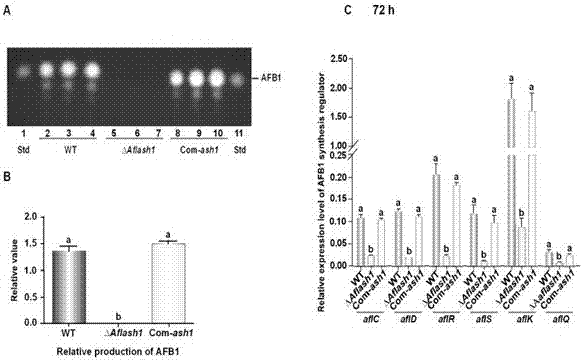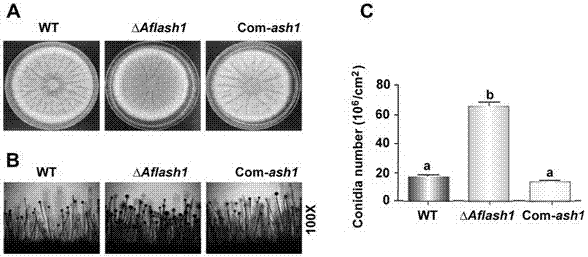Aspergillus flavus avirulent strain and application of Aspergillus flavus avirulent strain in controlling pollution of Aspergillus flavus
A kind of Aspergillus flavus strain and aflatoxin technology, applied in the field of microbiology, can solve the problem of pathogenicity and achieve the effect of pollution control
- Summary
- Abstract
- Description
- Claims
- Application Information
AI Technical Summary
Problems solved by technology
Method used
Image
Examples
Embodiment 1
[0043] Embodiment 1, in Aspergillus flavus aflash1 gene knockout
[0044] Aspergillus flavus aflash1 Gene function in Aspergillus flavus morphogenesis and pathogenicity, first knockout in Aspergillus flavus aflash1 Gene.
[0045] figure 1 A shows the strategy for gene knockout. in vitro construction aflash1 Gene knockout fragment, through homologous recombination method, the 2.5 kb in the chromosome aflash1 Aspergillus fumigatus pyrG replacement, thereby knocking out the chromosomal aflash1 Gene.
[0046] The specific method is as follows:
[0047] Using the 5' primer CAGTAACGATCCTCGCAATTACTCCATG (p1); and the 3' primer TCGTGCGTGTGCTTATTGAGGTCT (p2); the upstream fragment of about 1.2 kb was amplified by PCR from the genomic DNA of Aspergillus flavus PTS strain; using the 5' primer TTTTGGGCTCGTTGGCTACATAGGAATAC (p3); and 3 'Primer AGCCTTCCAGGAGGATGAACCTG (p4); Amplify about 1.2kb downstream fragment by PCR from genomic DNA of Aspergillus flavus PTS strain; us...
Embodiment 2
[0048] Embodiment 2, aflatoxin extraction and analysis
[0049] Inoculate the Aspergillus flavus spores of each bacterial strain in YES liquid medium (concentration is 10 6 cells / mL), cultured in the dark at 29 ℃ for 6 days, then absorbed 500 µL of liquid medium, added an equal volume of chloroform, vortexed to mix, centrifuged at high speed for 5 min, absorbed the organic phase liquid, dried and re-introduced with 200 µL of chloroform Dissolve and sample 10 µL for thin-layer chromatography (TLC) analysis. figure 2 show knockout aflash1 After the gene, ⊿ Aflash1 The strain does not produce AFB1, AFB2, AFG1, and AFG2.
[0050] The wild-type Aspergillus flavus strain can synthesize aflatoxin in large quantities; aflash1 After gene complementation (Com- ash1 strains) aflatoxin synthesis levels recovered. Further Q-PCR analysis revealed that the knockout aflash1 after gene wxya , wxya , wxya , wxya , wxya genes, and wxya The expression of toxin-producing ...
Embodiment 3
[0051] Embodiment 3, aflash1 The Effect of Gene Knockout on Sporulation of Aspergillus flavus
[0052] Will WT, ⊿ Aflash1 and com -ash1 After the Aspergillus flavus strains were cultured on YES solid medium at 37 ℃ for 4 days, the sporulation of each strain was observed. It was found that on the artificial medium ⊿ Aflash1 The strain produced a large number of green spores, and the statistical analysis of the data also found that ⊿ Aflash1 The number of spores produced by the strain was more than three times that of WT, ( image 3 A, B, C).
[0053] This result shows that, aflash1 The deletion of the gene led to a significant increase in sporulation of Aspergillus flavus on the artificial medium.
PUM
 Login to View More
Login to View More Abstract
Description
Claims
Application Information
 Login to View More
Login to View More - R&D
- Intellectual Property
- Life Sciences
- Materials
- Tech Scout
- Unparalleled Data Quality
- Higher Quality Content
- 60% Fewer Hallucinations
Browse by: Latest US Patents, China's latest patents, Technical Efficacy Thesaurus, Application Domain, Technology Topic, Popular Technical Reports.
© 2025 PatSnap. All rights reserved.Legal|Privacy policy|Modern Slavery Act Transparency Statement|Sitemap|About US| Contact US: help@patsnap.com



